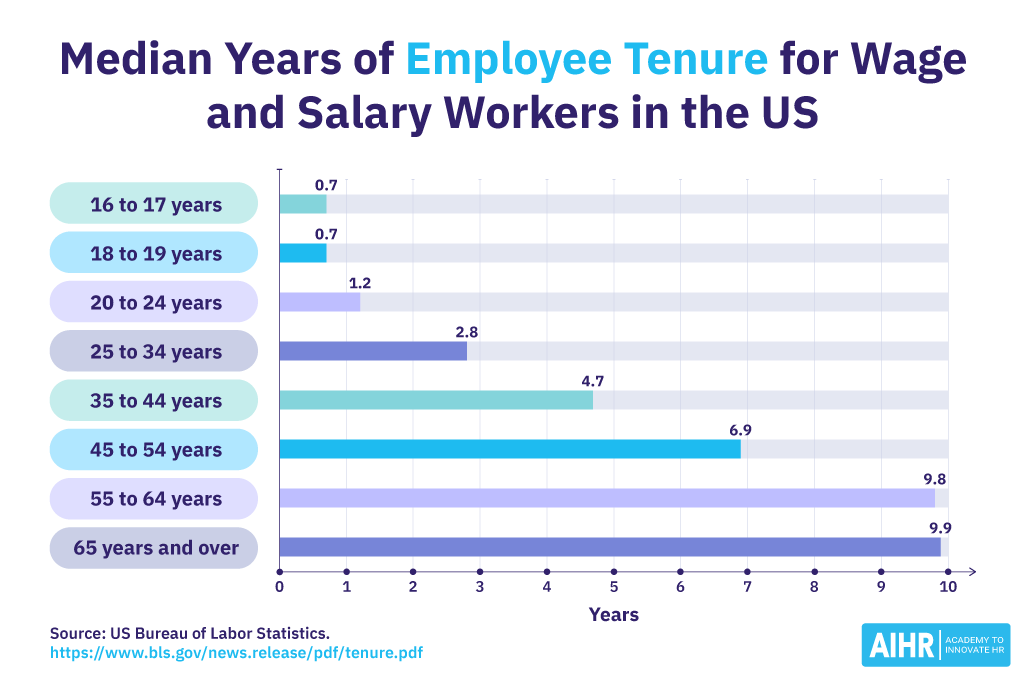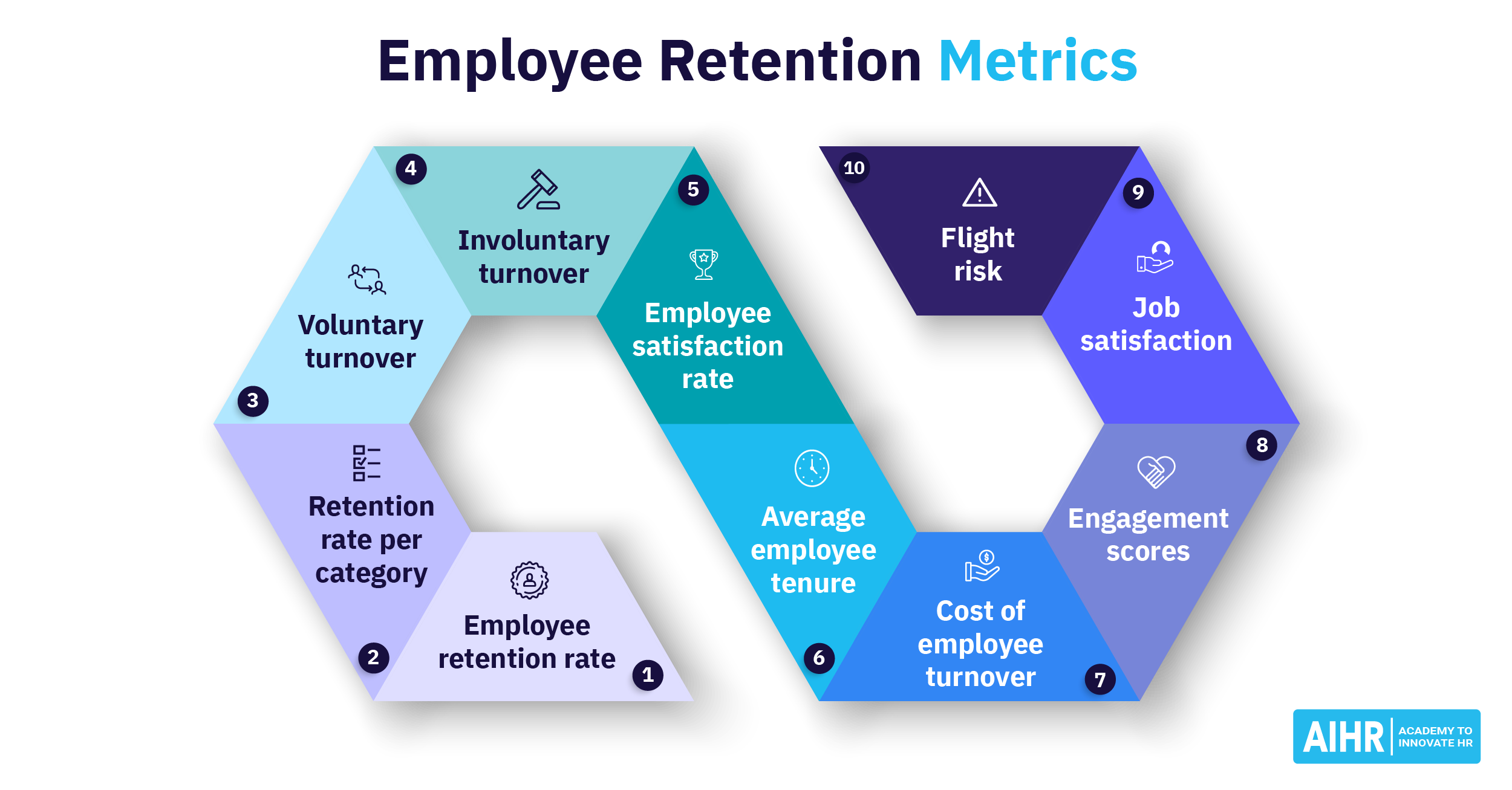Employee Tenure
What is employee tenure?
Employee tenure, also known as job tenure, refers to the duration of time an employee works for a single company or organization before moving on to another job or employer. This metric can provide insights into employee satisfaction, engagement, and organizational stability, and highlight red flags and opportunities for change.
Employee tenure can serve as an indicator of various aspects of an organization. Longer tenures may suggest higher job satisfaction and stronger employee engagement, while shorter ones might indicate job satisfaction issues or other factors that prompt employees to leave. Shorter tenures may also result from insufficient opportunities for learning, career advancement, or personal development. High turnover rates can also negatively impact an organization’s stability and productivity, as it could lead to disruptions and increased recruitment and training costs.
Types of employee tenure
As you may have noticed, there are two types of employee tenure: short and long.
1. Short tenure
Short-tenured employees usually work at an organization for a brief period of time, generally less than five years. For example: a recent graduate student who joined a startup but left after a few months for a better opportunity.
2. Long tenure
Long-tenured employees generally work at a company for an extended period of time, generally 5 years or longer. For example: a professor who has been teaching at a university for over 20 years.
The Bureau of Labour Statistics reports that the average employee tenure is 4.1 years. Below is BLS’s 2022 data for average employee tenure by industry.
| Sector | Industry | Average tenure |
|---|---|---|
| Private sector | All private Agricultural Manufacturing Wholesale/retail Transportation Information Financial activities Real estate Professional/business services Education and health services Leisure and hospitality | 3.1 years 4.7 years 5.2 years 3.1 years 3.7 years 4.2 years 4.5 years 3.9 years 3.4 years 4 years 2 years |
| Public sector | Overall public Federal government State government Local government | 6.8 years 7.5 years 6.3 years 6.9 years |
| Total | 4.1 years |
What is a good employee tenure?
A good government employee tenure is typically more than five years. Government employees often have better benefits than private sector employees, so they tend to stay onboard for longer.
Within the private sector, the lowest tenures (below the median of 4.1 years) are in leisure and hospitality, wholesale and retail, and professional and business services. Manufacturers have the highest tenure in the private sector particularly since the industry has seen drastic changes due to COVID-19.

What are the advantages of long employee tenure?
- Increased loyalty to the organization: Loyal, content employees lead to a thriving, productive workforce. Employees who are happy with an organization will want to engage and perform well. Long-lasting, committed employees boost employer branding to attract top talent, customers, and partners.
- Reduced turnover costs: Recent research from the SHRM indicates that the cost of hiring a new employee can be three or four times the position’s salary. This includes recruitment and vacancy expenses—for example, hiring an interim contractor. The company may also have to pay unemployment and legal fees for the employees who leave. When a new employee comes on, the employer must also pay for onboarding and training. A revolving door of employees also affects everyone’s morale and productivity.
- Greater expertise and knowledge: An employee who’s stayed with an organization for a long time is familiar with the product, services, and industry. They’ve also built internal and external relationships. Internally, they work with other team members, managers, SMEs, and other departments; externally, they may interface with prospective and current customers, partners, and vendors. The employee can leverage their knowledge and relationships not only for their benefit but also to help others.
What are the disadvantages of long employee tenure?
- Potentially limited learning and advancement: An employee may fall into a pattern of working on the same tasks and with the same colleagues for a long time. This limits their skills expansion, knowledge acquisition, and opportunities to challenge themselves.
- Complacency that leads to lower performance: Employees who’ve stayed at an organization for a while may not be motivated to go above and beyond. The minimum goals are good enough, and their long tenure may cause managers to overlook some performance gaps.
- Succession planning challenges: Long-tenured employees are highly valuable for an organization, generally occupying critical roles. Having a succession plan in place is essential to ensure their roles are not left vacant when these employees retire or leave.
HR tip
Offer gifts, prizes, or other rewards to celebrate an employee’s tenure. Some ideas are gift cards, company merchandise, or a company celebration. Give long-tenure employees a recognition letter from company leadership or a larger prize like a travel voucher. Offering gifts and incentives shows employees the organization appreciates their loyalty and commitment.
How can you calculate employee tenure?
You can easily calculate the average employee tenure in your organization in Excel based on the employee’s start date and end date.
- Format your list as a table.
- Create 3 columns: employee name (A), start date (B), and end date (C).
- In column D, you can calculate the employee tenure with the following formula:
=IF([end-date]=””;(((TODAY()-[start-date])/365));([end-date]-[start-date])/365) - The =IF([end-date]=””;(((TODAY()-[start-date])/365)) part of the formula checks if there’s an end date in Column C. If there isn’t (the employee is still with the company), it uses today’s date (TODAY()) as the end date.
- The formula then subtracts the start date from the end date to get the tenure in days.
- The formula in Excel will look like this: =IF(C2=””;(((TODAY()-B2)/365));(C2-B2)/365)
You can break it down by category, such as the tenure per department, division, or team. Add details like the employee’s age, gender, or job level. Incorporate influential factors. For example, an employee with less than five years of work experience may not have a long tenure.
The data will give you reliable insight into the state of your organization. Are you seeing a higher level of turnover in one department? Consider possible reasons like the average work or education experience. Use the information to guide your business strategies and decisions.
How can HR help increase employee tenure?
HR plays a main role in increasing employee tenure by creating a positive work environment, offering learning and development opportunities, and making sure that employees feel valued and supported. Here are several strategies that HR can put in place to enhance employee tenure:
- Create a robust recruitment process
- Foster career development and progression
- Drive employee engagement initiatives
- Arrange flexible work options
- Provide appropriate compensation and benefits
- Have a constructive performance and feedback mechanism in place
- Promote an inclusive and diverse culture
- Recognize employees for performance, tenure, ideas, etc.







